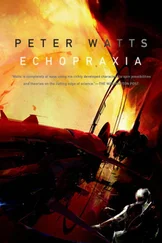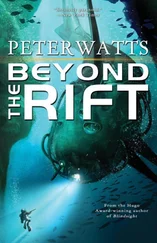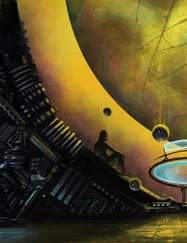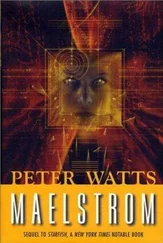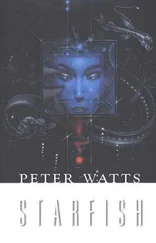I możecie mi wierzyć lub nie, ale krzyczące twarze, których używał Sarasti pod koniec książki, to prawdziwy sposób wizualizacji danych statystycznych. Twarze Chernoffa 143skuteczniej niż standardowe wykresy i tabele ukazują charakterystykę zbiorów danych 144.
1. http://www.rifters.com/blindsight/vampires.htm
2. Pennish, E. 2003. Cannibalism and prion disease may have been rampant in ancient humans. „Science” nr 300, s. 227-228.
3. Mead, S. et al. 2003. Balancing Selection at the Prion Protein Gene Consistent with Prehistoric Kurulike Epidemics. „Science” nr 300, s. 40-643.
4. Autor nieznany, 2004. Autism: making the connection. „The Economist”, nr 372(8387), s. 66.
5. Balter, M. 2002. What made Humans modern? „Science” nr 295, s. 1219-1225.
6. Blanco-Arias, P., C.A. Sargent, and N.A. Affara. 2004. A comparative analysis of the pig, mouse, and human PCDHX genes. „Mammalian Genome”, nr 15(4), s. 296-306.
7. Kreider MS, et al. 1990. Reduction of thyrotropin-releasing hormone concentrations in central nervous system of African lungfish during estivation. „Gen Comp Endocrinol” nr 77(3), s. 435-41.
8. Cui, Y. et al. 1996. State-dependent changes of brain endogenous opioids in mammalian hibernation. Brain Research Bulletin 40(2): 129-33.
9. Miller, K. 2004. Mars astronauts ‘will hibernate for 50 million-mile journey in space’. News.telegraph.co.uk, 11/8/04.
10. Calvin, W.H. 1990. The Cerebral Symphony: Seashore Reflections on the Structure of Consciousness. Bantam Books, NY.
11. Pennisi, E. 2004. The first language? „Science” nr 303, s. 1319-1320.
12. Nagrania opartych na mlaskach fonemów języka hadza są dostępne w sieci: http://hctv.humnet.ucla.edu/departments/linguistics/VoweIsandConsonants/index.html
13. Ramachandran, V.S. 1990. str. 346-360 w: The Utilitarian Theory of Perception, C. Blakemore (Ed.), Cambridge University Press, Cambridge.
14. Purves, D. and R.B. Lotto. 2003. Why We See What We Do An Empirical Theory of Vision. Sinauer Associates, Sunderland, MA.
15. Yarbus, A.L. 1967. Eye movements during perception of complex objects. W: L. A. Riggs, Ed., Eye Movements and Vision, Plenum Press, New York, Rozdział VII, s. 171-196.
16. Pringle, H.L., et al. 2001. The role of attentional breadth in perceptual change detection. „Psychonomic Bulletin & Review” nr 8, s. 89-95(7)
17. Simons, D.J., and Chabris, C.F. 1999. Gorillas in our midst: sustained inattentional blindness for dynamic events. „ P erception” 28, s. 1059-1074
18. Simons, D.J., and Rensink, R.A. 2003. Induced Failures of Visual Awareness. Journal of Vision” nr 3(1).
19. http://viscog.beckman.uiuc.edu/djs_lab/demos.html
20. Metzinger, T. 2003. Being No One: The Self Model Theory of Subjectivity. MIT Press, Cambridge, MA.
21. Wegner, D.M. 2002. The Illusion of Conscious Will. MIT Press, Cambridge.
22. Saks, O. 1970. The Man who mistook his wife for a hat and other clinical tales. Simon & Shuster, NY.
23. American Psychiatric Association. 2000. Diagnostic and Statistical Manual of Mental Disorders (wyd. 4 popr.). Brandon/Hill.
24. Ramachandran, V.S., and Blakeslee, S. 1998. Phantoms in the Brain: Probing the Mysteries of the Human Mind. William Morrow, New York.
25. Persinger, M.A. 2001. The Neuropsychiatry of Paranormal Experiences. „J Neuropsychiatry & Clinical Neuroscience” nr 13, s. 515-524.
26. Kamitani, Y. and Shimojo, S. 1999. Manifestation of scotomas created by transcranial magnetic stimulation of human visual cortex. „Nature Neuroscience” nr 2, s. 767-771.
27. Hallett, M. 2000. Transcranial magnetic stimulation and the human brain. „Nature” nr 406, s. 147-150.
28. Goldberg, C. 2003. Zap! Scientist bombards brains with super-magnets to edifying effect. „Boston Globe” 14/1/2003, s. E1.
29. Porter, R., and Lemon, R. 1993. Corticospinal function and voluntary movement. Oxford University Press, NY.
30. Delgado, J.M.R. 1969. Physical control of the mind: toward a psychocivilised society. Harper & Row, NY.
31. Libet, B. 1993. The neural time factor in conscious and unconscious events. „Experimental and Theoretical Studies of Consciousness” nr 174, s. 123-146.
32. P. Haggard, R, and Eimer, M. 1999. On the relation between brain potentials and the awareness of voluntary movements. „Experimental Brain Research” nr 126, s. 128-133.
33. Velmans, M. 2003. Preconscious free will. „Journal of Consciousness Studies” nr 10, s. 42-61.
34. Pinto, C. 2003. Putting the brain on trial. „Media General News Service”, 5.05.2003
35. Macmillan, M. 2000. An Odd Kind of Fame Stories: of Phineas Gage. MIT Press, Cambridge, MA.
36. Ehrsson, H.H., C. Spence, and R.E. Passingham 2004. That’s My Hand! Activity in Premotor Cortex Reflects Feeling of Ownership of a Limb. „Science” nr 305, s. 875-877.
37. Gottleib, J., and P. Mazzoni. 2004. Action, illusion, and perception. „Science” nr 303, s. 317-318.
38. Schwartz, A.B., D.W. Moran, and G.A. Reina. 2004. Differential representation of perception and action in the frontal cortex. „Science” nr 303, s. 380-383.
39. Norton, S.J., 2003. Can ultrasound be used to stimulate nerve tissue? „BioMedical Engineering OnLine” nr 2, s. 6, dostępne pod http://www.biomedical-engineering-online.com/content/2/1/6.
40. Hogan, J., and Fox, B. 2005. Sony patent takes first step towards real-life Matrix. Fragment z: „New Scientist” nr 2494, s. 10, dostępny pod: http://www.newscientist.com/article.ns?id=mg18624944.600
41. Riebe, M. et al. 2004. Deterministic quantum teleportation with atoms. „Nature” nr 429, s. 734-737.
42. Furusawa, A. et al. 1998. Unconditional Quantum Teleportation. „Science” nr 282(5389), s. 706-709
43. Carlton M. Caves, C.M. 1998. A Tale of Two Cities. „Science” nr 282, s. 637-638
44. Braunstein, S.L., and Kimble, H.J. 1998. Teleportation of continuous quantum variables. „Physical Review Letters” nr 80, s. 869-872.
45. http://www.research.ibm.com/quantuminfo/teleportation/
46. http://math.ucr.edu/home/baez/physics/Relativity/SR/rocket.html
47. Atkinson, N. 2004. Magnetic Bubble Could Protect Astronauts on Long Trips. „Universe Today”, http://www.universetoday.com/am/publish/magnetic_bubble_protect.html
48. Holzscheiter, M.H., et al. 1996. Production and trapping of antimatter for space propulsion applications. American Institute of Aeronautics and Astronautics-1996-2786 ASME, SAE, and ASEE, Joint Propulsion Conference and Exhibit, 32nd, Lake Buena Vista, FL, 1-3.06.1996.
49. www.engr.psu.edu/antimatter/Papers/NASA_anti.pdf
50. Blacstone, E., et al. 2005. H 2 S Induces a Suspended Animation-Like State in Mice. „Science” nr 308, s. 518.
51. Do czasu druku książki te dane nie zostały opublikowane.
52. Bails, J. 2005. Pitt scientists resurrect hope of cheating death. „Pittsburgh Tribune-Review”, 29.06.2005. Available online at http.//www.pittsburghlive.com/x/tribune-review/trib/regional/s_348517.html
53. Oasa, Y. et al. 1999. A deep near-infrared survey of the chamaeleon i dark cloud core. „Astrophysical Journal” nr 526, s. 336-343.
54. Normile, D. 2001. Cosmic misfits elude star-formation theories. „Science” nr 291, s. 1680.
Читать дальше


